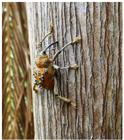ABSTRACT:
The weevil Ozopherus muricatus Pascoe, 1872 (Coleoptera: Curculionidae) is already considered a pest in Brazil for açaí palm (Euterpe oleracea Mart.) plantations. Its presence has become more frequent and caused significant reduction in the production of açaí fruit. Studies on the biology of this insect pest are still scarce, hindering its management. For studies on pheromones, for instance, it is essential to correctly identify the sex of the insect. The objective of this study was to evaluate the existence of sexual dimorphism in pupae and adults of O. muricatus in order to allow the identification of males and females. Larvae, pupae and adults were collected from açaí plantations and kept in biochemical oxygen demand (BOD) type incubation chambers. Adults and pupae were examined under a stereomicroscope, and dimorphism was determined through observation of external morphological characteristics. In addition, adults were dissected in order to observe genitalia and confirm the sex of specimens. In the pupae, sexual dimorphism was characterized by the presence of two protuberances in the terminal ventral region of the abdomen of females, which were absent in males. In adults, sexual dimorphism was also observed, based on the final abdominal segments. In males, it was possible to see all eight abdominal tergites, while in females tergite VIII is covered by tergite VII. Thus, the sexual dimorphism present in the morphological characteristics of O. muricatus allows the distinction between males and females of this species.
KEYWORDS:
morphology; sex differentiation; sex determination; açaí palm; Arecaceae

 Thumbnail
Thumbnail
 Thumbnail
Thumbnail

 T VII: tergite VII; T VIII: tergite VIII.
T VII: tergite VII; T VIII: tergite VIII.